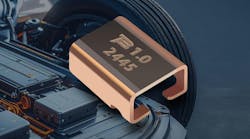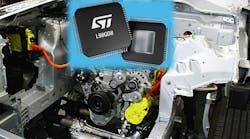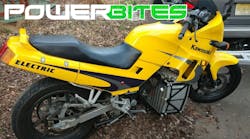Compact Zener Diodes Protect Automotive Electronics
What you'll learn:
- How Toshiba's new Zener diode series suppress ESD-triggered ECU malfunctions.
- The diodes' compact packaging that suits them for multiple automotive applications.
Toshiba Electronics Europe’s XCEZ series of surge-protection Zener diodes are engineered to suppress system malfunctions of a vehicle’s electronic control units (ECUs) caused by electrostatic discharges in the nanosecond range and switching surges in the microsecond to millisecond range.
The AEC-Q101-compliant devices are housed in a small and versatile SOD-523 package, which suits them for space-constrained applications such as in-vehicle Infotainment (IVI), advanced driver-assistance systems (ADAS), and battery-management systems (BMS).
The XCEZ series, like its predecessor, the XCUZ series, leverages Toshiba’s proprietary Zener process to achieve exceptionally low dynamic resistance. A low dynamic resistance allows surge current to flow more easily to the Zener diode, enabling high absorption of the surge voltage to prevent damage and malfunction of the system and enhancing protection of devices and circuits.
For instance, the XCEZ5V6 features a dynamic resistance (RDYN) of just 0.16 Ω (typ.).
The diodes provide surge protection for long pulse durations in the millisecond range. They achieve a high maximum allowable Zener surge power of 6 W with a 10-ms pulse width.
The XCEZ series is offered with standard Zener voltages ranging from 5.6 to 36 V. The general-purpose SOD-523 package, measuring a mere 1.6 × 0.8 mm, reduces the mounting area by approximately 59% compared to the SOD-323 package (2.5 × 1.25 mm) used for its existing XCUZ series.
Next in This Edition of PowerBites
More PowerBites
About the Author
Lee Goldberg
Contributing Editor
Lee Goldberg is a self-identified “Recovering Engineer,” Maker/Hacker, Green-Tech Maven, Aviator, Gadfly, and Geek Dad. He spent the first 18 years of his career helping design microprocessors, embedded systems, renewable energy applications, and the occasional interplanetary spacecraft. After trading his ‘scope and soldering iron for a keyboard and a second career as a tech journalist, he’s spent the next two decades at several print and online engineering publications.
Lee’s current focus is power electronics, especially the technologies involved with energy efficiency, energy management, and renewable energy. This dovetails with his coverage of sustainable technologies and various environmental and social issues within the engineering community that he began in 1996. Lee also covers 3D printers, open-source hardware, and other Maker/Hacker technologies.
Lee holds a BSEE in Electrical Engineering from Thomas Edison College, and participated in a colloquium on technology, society, and the environment at Goddard College’s Institute for Social Ecology. His book, “Green Electronics/Green Bottom Line - A Commonsense Guide To Environmentally Responsible Engineering and Management,” was published by Newnes Press.
Lee, his wife Catherine, and his daughter Anwyn currently reside in the outskirts of Princeton N.J., where they masquerade as a typical suburban family.
Lee also writes the regular PowerBites series.





